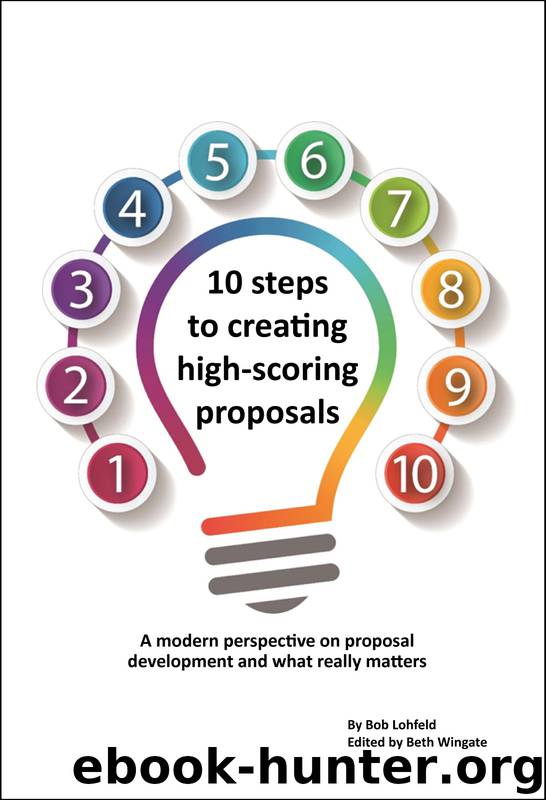10 steps to creating high-scoring proposals: A modern perspective on proposal development and what really matters by Lohfeld Bob

Author:Lohfeld, Bob
Language: eng
Format: epub
Publisher: Lohfeld Consulting Group, Inc.
Published: 2017-04-18T16:00:00+00:00
Action #8
Communicate your message visually
1.Use visual communications to convey strengths
2.Communicate your message for visual evaluators
3.Make strengths pop off the page
4.Use the sleepy evaluator test
Visual communications is one of my favorite topics. We use the term visual communications as opposed to graphics because what we are doing is taking our message about strengths and trying to communicate those strengths visually to the reviewers. This may sound like a subtle distinction between graphics and visual communications, but it is more significant than that. Visual communications begins by listing the strengths we want to communicate and then figuring out how to convey them visually. It does not begin by selecting a graphic and trying to shoehorn your features into it.
We learned the importance of visual communications through conducting numerous review exercises. If you take a team of really smart people, and you ask them to evaluate a proposal and watch how they evaluate it, one third of the team will go through that proposal, read the text, and skip over every figure in the proposal. They’ll skip over the data in every table, and they’ll just read the words. They’re text readers, and they don’t see the graphics on the page, the visual communications on the page, or the tables on the page.
You can prove this to yourself. Watch them evaluate. At about five pages into the proposal, have everyone close their laptops or turn the proposal face down on the table. Then ask how many people in the room can tell you what was in the graphic on the second page. They may give you some generalization, and then you begin to probe beyond that to see how many of them really saw what was in the graphic.
You’ll be shocked at how few can come back to you and tell you what’s there.
Another third of the evaluators can tell in detail what was in the figures and tables. They are typically the engineers or the scientists. The highly technical people tend to focus on data and will skip the words. They’ll look at the flow diagrams and the data in the tables, and they will evaluate your proposal based on what they perceive visually. You have the left brain/right brain thing going on here.
We use visual communications to convey your strengths to evaluators who don’t read text.
We also know that the more proposals the government evaluators review, the more important visual communications becomes. As evaluators get tired, they default to visual communications. They skim the proposal looking for features that pop off the page, or key words in paragraphs, or action captions under tables and figures. This makes it doubly important that we design proposals with good visual communications.
To communicate effectively, we must communicate our message across two frequencies. One is text, and one is visual. To accomplish this vitally important visual communication, our strengths must pop off the page. We should use ways to highlight them using bold text, italics, pull quotes, colors, or icons—whatever you want from an artistic point of view.
Download
This site does not store any files on its server. We only index and link to content provided by other sites. Please contact the content providers to delete copyright contents if any and email us, we'll remove relevant links or contents immediately.
Bad Blood by John Carreyrou(6271)
Rich Dad Poor Dad by Robert T. Kiyosaki(6174)
Principles: Life and Work by Ray Dalio(5954)
Playing to Win_ How Strategy Really Works by A.G. Lafley & Roger L. Martin(5487)
Management Strategies for the Cloud Revolution: How Cloud Computing Is Transforming Business and Why You Can't Afford to Be Left Behind by Charles Babcock(4438)
The Confidence Code by Katty Kay(4033)
Thinking in Bets by Annie Duke(3995)
American Kingpin by Nick Bilton(3503)
Delivering Happiness by Tony Hsieh(3280)
Project Animal Farm: An Accidental Journey into the Secret World of Farming and the Truth About Our Food by Sonia Faruqi(3013)
The Power of Habit by Charles Duhigg(2962)
Mastering Bitcoin: Programming the Open Blockchain by Andreas M. Antonopoulos(2889)
Brotopia by Emily Chang(2889)
The Tyranny of Metrics by Jerry Z. Muller(2845)
I Live in the Future & Here's How It Works by Nick Bilton(2841)
The Marketing Plan Handbook: Develop Big-Picture Marketing Plans for Pennies on the Dollar by Robert W. Bly(2792)
The Content Trap by Bharat Anand(2776)
Building a StoryBrand by Donald Miller(2751)
Applied Empathy by Michael Ventura(2742)
